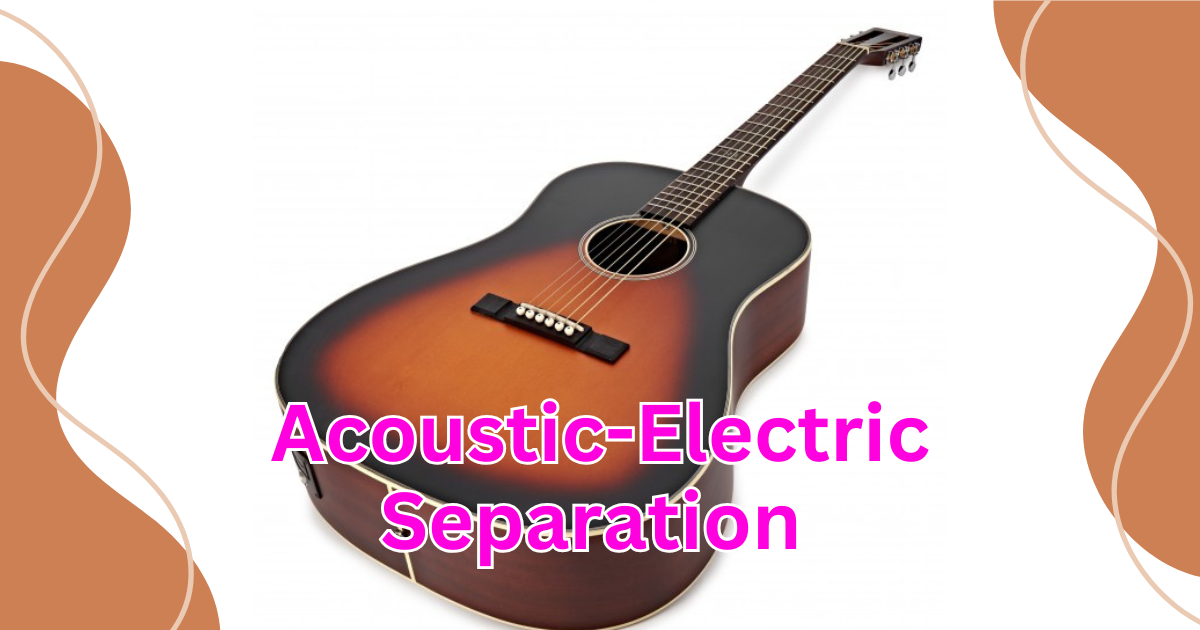Understanding Acoustic-Electric Separation: 10 Key Insights for Guitar Enthusiasts
Acoustic-electric separation has revolutionized the way musicians interact with their instruments. This blog post will delve into the nuances of this technology, explaining its importance and applications in modern guitar playing.
Table of Contents
- What is Acoustic-Electric Separation in Guitars?
- The Role of Pickups in Acoustic-Electric Separation
- Differences Between Acoustic and Electric Guitar Sounds
- How Does Acoustic-Electric Technology Work?
- Advantages of Acoustic-Electric Guitars for Musicians
- Understanding Piezo and Magnetic Pickups
- Sound Engineering and Acoustic-Electric Guitars
- Choosing the Right Acoustic-Electric Guitar for Your Style
- The Future of Acoustic-Electric Guitar Technology
- FAQs on Acoustic-Electric Separation in Guitars
What is Acoustic-Electric Separation in Guitars?
Acoustic-electric separation refers to the process of distinguishing and managing the sound generated by acoustic and electric components in hybrid guitars. These instruments combine traditional acoustic elements with electronic pickups to amplify sound, giving musicians the versatility to play in various settings, from intimate acoustic sessions to full-blown electric performances.
This separation is crucial because it allows musicians to maintain the natural tonal qualities of acoustic guitars while enhancing their sound for live performances and recordings. The blend of these two sound profiles leads to a richer and more dynamic musical experience.
The Role of Pickups in Acoustic-Electric Separation
Pickups are the heart of acoustic-electric separation. They capture the vibrations of the strings and convert them into electrical signals that can be amplified. There are primarily two types of pickups used in acoustic-electric guitars: piezo pickups and magnetic pickups.
Piezo Pickups
Piezo pickups are commonly used in acoustic guitars. They work by placing a small sensor under the bridge of the guitar, which detects the vibrations from the strings and the guitar body. This technology effectively captures the natural sound of the guitar, preserving its acoustic qualities while allowing for amplification.
Magnetic Pickups
In contrast, magnetic pickups are more associated with electric guitars. They use magnets and coils to capture the vibrations of the strings. When strings vibrate, they disturb the magnetic field created by the pickups, generating an electric signal. Magnetic pickups can sometimes produce a different sound compared to piezo pickups, which may not suit every musician’s style.
Understanding these different pickups is essential for anyone interested in acoustic-electric separation. Choosing the right type will significantly impact the overall sound and performance.
Differences Between Acoustic and Electric Guitar Sounds
The sounds produced by acoustic and electric guitars are inherently different due to their construction and design.
- Acoustic Guitars produce sound through the vibration of their strings and the resonance of the body. This results in a warm, natural tone that is ideal for genres like folk and classical music.
- Electric Guitars, on the other hand, rely on electronic amplification to produce sound. They can achieve a wider range of tones, from clean and crisp to heavy distortion, making them suitable for various genres like rock, metal, and jazz.
Acoustic-electric guitars aim to bridge the gap between these two worlds, allowing musicians to enjoy the best of both instruments. The separation of sound allows for a unique blend that caters to different musical styles.
How Does Acoustic-Electric Technology Work?
Acoustic-electric technology operates by integrating the acoustic body of a guitar with electronic components, primarily pickups and preamps. Here’s a simplified overview of how it works:
- Sound Production: When a guitarist strums or plucks the strings, the vibrations resonate through the acoustic body, producing sound.
- Sound Capture: The pickups capture these vibrations. In piezo systems, sensors under the bridge pick up the vibrations of both the strings and the body. Magnetic pickups detect string vibrations.
- Signal Conversion: The vibrations are converted into electrical signals by the pickups.
- Amplification: The electrical signals are sent to an amplifier or a mixing board, where they can be modified and enhanced.
- Output: Finally, the amplified sound is projected through speakers or PA systems, allowing the audience to enjoy the rich tones of the acoustic-electric guitar.
This technology enables musicians to perform in larger venues without losing the essence of their acoustic sound, creating a more engaging experience for both the performer and the audience.
Advantages of Acoustic-Electric Guitars for Musicians
Acoustic-electric guitars offer several advantages:
- Versatility: Musicians can switch between acoustic and electric sounds, adapting to various musical styles and settings.
- Performance Flexibility: They can be easily amplified for larger audiences without sacrificing the acoustic sound quality.
- Recording Ease: Acoustic-electric guitars are ideal for studio recordings, where capturing natural tones while allowing for amplification is crucial.
- Enhanced Control: Musicians can adjust tone and volume levels through onboard electronics, enabling greater control over their sound.
These benefits make acoustic-electric guitars a popular choice for many musicians, especially those who perform live.
Understanding Piezo and Magnetic Pickups
The choice between piezo and magnetic pickups can greatly influence the sound of an acoustic-electric guitar.
Piezo Pickups
As mentioned, piezo pickups offer a natural, uncolored sound. They are best for musicians who want to maintain the acoustic guitar’s essence while adding amplification. However, they can sometimes produce a harsher sound if not properly adjusted or if the guitar is not of high quality.
Magnetic Pickups
Magnetic pickups, while typically associated with electric guitars, can also be used in acoustic-electric models. They tend to produce a warmer sound but may not capture the full spectrum of an acoustic guitar’s tonal range. Musicians who prefer a more electric sound might favor magnetic pickups.
When selecting an acoustic-electric guitar, understanding the differences between these pickups will help musicians choose an instrument that aligns with their sound preferences.
Sound Engineering and Acoustic-Electric Guitars
Sound engineering plays a crucial role in the performance of acoustic-electric guitars. Engineers use various techniques to enhance the sound produced by these instruments, ensuring that they blend well with other instruments in a live setting or in a recording studio.
Equalization
Equalization (EQ) is often used to adjust the tonal balance of an acoustic-electric guitar. Engineers can boost or cut specific frequencies to enhance clarity or warmth, depending on the desired sound.
Effects Processing
Effects such as reverb, delay, and compression can significantly alter the guitar’s sound. These effects can help create a more immersive listening experience, allowing musicians to express their artistic vision.
Feedback Control
Feedback is a common issue when amplifying acoustic-electric guitars. Sound engineers must carefully position microphones and adjust levels to minimize feedback while maintaining sound quality.
Understanding these sound engineering principles can help musicians and sound engineers work together effectively, resulting in a polished performance.
Choosing the Right Acoustic-Electric Guitar for Your Style
When selecting an acoustic-electric guitar, consider the following factors:
- Pickups: Decide between piezo and magnetic pickups based on your sound preferences.
- Body Type: Different body shapes (dreadnought, concert, parlor) produce varying tones. Try out different types to see which resonates with you.
- Brand and Model: Research reputable brands known for quality acoustic-electric guitars, such as Taylor, Martin, and Gibson.
- Budget: Determine your budget, as prices can vary significantly. There are great options available for various price ranges.
- Playability: Ensure the guitar feels comfortable to play. A good setup can make a huge difference in playability.
By taking these factors into account, musicians can find an acoustic-electric guitar that suits their style and enhances their playing experience.
The Future of Acoustic-Electric Guitar Technology
The acoustic-electric guitar market is continually evolving, with new technologies emerging to enhance sound and playability. Some trends to watch for include:
- Advanced Pickup Systems: Companies are developing more sophisticated pickup systems that capture a wider range of frequencies and provide more natural sound.
- Integrated Effects: Some guitars now come with built-in effects, allowing musicians to experiment with sound without additional gear.
- Smart Technology: Innovations like Bluetooth connectivity and integrated tuners are becoming more common, making it easier for musicians to enhance their playing experience.
As technology advances, acoustic-electric guitars will likely become even more versatile and user-friendly, enabling musicians to push the boundaries of their creativity.
FAQs on Acoustic-Electric Separation in Guitars
- What is acoustic-electric separation?
- It refers to distinguishing the sounds produced by acoustic and electric components in hybrid guitars.
- How do piezo pickups work?
- Piezo pickups capture vibrations from the guitar body and strings, converting them into electrical signals.
- What are the advantages of acoustic-electric guitars?
- They offer versatility, performance flexibility, and ease of recording.
- What is the difference between piezo and magnetic pickups?
- Piezo pickups capture naturalsound, while magnetic pickups offer a warmer, electric tone.
- Can I use an acoustic-electric guitar for live performances?
- Yes, acoustic-electric guitars are ideal for live performances as they can be amplified without losing their acoustic quality.
- Do acoustic-electric guitars require batteries?
- Some models with active pickups or onboard electronics may require batteries for amplification and effects.
- How do I maintain my acoustic-electric guitar?
- Regular cleaning, proper storage, and checking the electronics will help maintain your guitar.
- Are acoustic-electric guitars suitable for beginners?
- Yes, they can be a great option for beginners due to their versatility and ease of use.
- What genres of music can I play with an acoustic-electric guitar?
- Acoustic-electric guitars are versatile and can be used in various genres, including folk, rock, country, and blues.
- Can I record directly from an acoustic-electric guitar?
- Yes, you can connect it directly to an audio interface for recording, making it a convenient choice for home studios.
Conclusion
Acoustic-electric separation is a game changer for musicians looking to blend the warmth of acoustic sound with the versatility of electric amplification. By understanding the nuances of pickups, sound engineering, and technology advancements, musicians can enhance their performances and recordings. Whether you are a seasoned player or a beginner, embracing the acoustic-electric guitar can significantly elevate your musical journey.
For more insights and resources, visit our homepage to explore more content: Magzineco.





Pingback: EtsiosApp Release Date Unveiled: The Ultimate Productivity Tool for 2025 - Magzineco